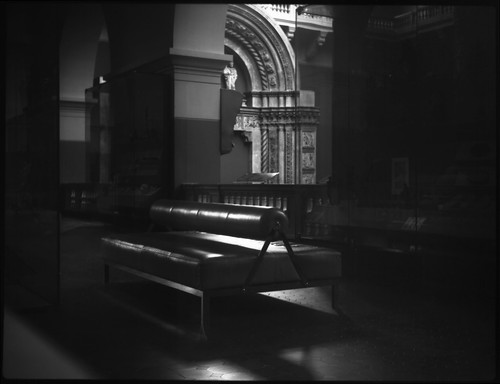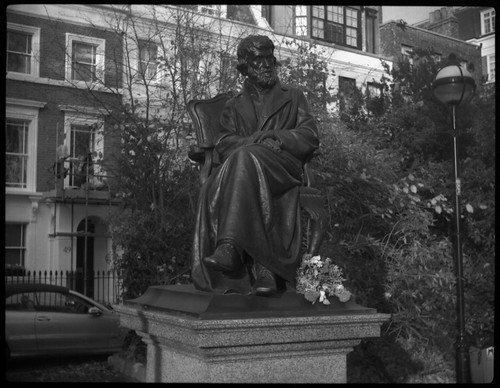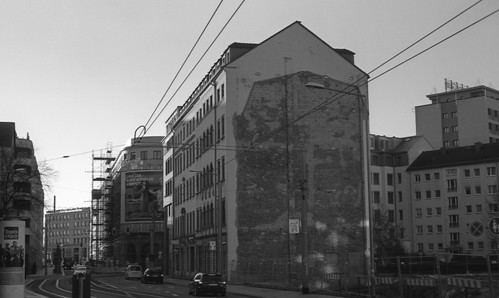.jpg)
For many years, it was known that Vermeer's painting Girl Reading a Letter at an Open Window originally had a large painting on its far wall parallel to the picture plane which had been painted over. It was believed that this had been done during the artist's lifetime, with the inevitable conclusion that this act was by the artist himself; more recent analysis had determined that a layer of dirt underneath the overpainted area must have taken decades to accumulate, and therefore the painting–or the version of it as had become familiar since the mid-nineteenth century ‘rediscovery’ of the artist–did not in fact reflect Vermeer’s intention for the work. The painting, held in the Staatliche Kunstsammlungen, Dresden was painstakingly restored, with the later overpaint removed, revealing a framed picture of Cupid holding up a playing card, which appears in two other works by Vermeer. The radically restored painting was the centrepiece of an exhibition, 'Johannes Vermeer: Vom Innenhalten (On Reflection)', at the Gemäldegalerie Alte Meister, housed in the Dresden Zwinger late last year.
A couple of years ago I wrote about my interest in the art of Vermeer in two posts, Cameras Obscura and A View of Delft. These were written after a trip to Delft, Amsterdam, and the Hague, and the work which I had made there, referencing the long-speculated upon use of optical technology–the camera obscura–by Vermeer, and by another Delft painter, Carel Fabritius, the evidence of which appears to be present in their paintings to a greater or lesser degree. This ‘pre-history’ of the photographic has long been an interest of mine, in relation to my own paintings and their relationship to photographic source material, and I had, in the past, made work with specific references to the paintings of Vermeer. As part of the Staatliche Kunstsammlungen Dresden’s accompanying programme to 'Johannes Vermeer: Vom Innenhalten', there was a small display in the Zwinger’s Café Algarotti. This showed three photographic works in dialogue with Girl Reading a Letter at an Open Window: Alfred Stieglitz’s Sun Rays—Paula, Berlin (1899), which depicts the photographer’s sister writing a letter by an open window, strikingly illuminated through slatted blinds; Tom Hunter’s Woman reading a Possession Order (1997), more directly referencing Vermeer’s painting; and my own After Vermeer. In the Zwinger’s display, this was a digital print, a composite image constructed from a number of photographs which had originated on film.
 |
| After Vermeer, digital composite |
As an artwork in its own right, this particular version of After Vermeer had only ever existed as an image on a website many years ago–it was made as a reference image for a painting, one component among others, a working image for part of a trompe l’oeil painting: the painting as a whole had the conceit that it shows a section of an artist’s studio wall. The photograph was paired with a photocopy of the two-page page spread showing the reproduction of Girl Reading a Letter by an Open Window from Arthur J. Wheelock’s book on Vermeer. In the painting, my version of the Vermeer composition appears as a photograph that the artist is working from to make a painting: in the trompe l’oeil, this image has a grid drawn (painted) onto it for the purpose of transferring the image, usually with an element of scaling up, to this notional painting’s surface.
 |
| The Artist's Studio I, oil on board, 56x72cm |
I had initially planned four trompe l’oeil paintings in the series of the studio wall. The painting with the photocopy of Vermeer’s Girl Reading a Letter at an Open Window was selected for the Royal Academy Summer Exhibition in 2001; a second painting, in the same format, with a photocopy of Edward Hopper’s Automat and my own composition based on it, wasn’t selected. I completed a third painting, with a composition of my own which was a more oblique referencing to one of Artemisia Gentilischi’s paintings of Susanna and the Elders, included within. The fourth painting in the series was started but never finished. All four paintings were designed to join together horizontally, with elements spanning from the edge of one painting to the next (that the compositions are cut off at the edges points to the paintings being ‘about’ or using the approach of trompe l’oeil, rather than being true trompe l’oeil works). I kept the board for the fourth painting for many years afterwards. It had a slight bit of painting of the overlapping newspaper clipping. Eventually this got damaged and the board was cut up to be re-used.
At the time I made this series, in early 2001, I had no intention of making singular paintings of my own compositions within them which refer to the historical paintings that were their inspiration. This was partly that I (then) had a resistance to making paintings that appeared as if (based on) a single photograph, a resistance I relinquished a year or so later. From the other trompe l’oeil paintings completed in the series I used the digital images of my compositions for two back-lit transparencies mounted on lightboxes which were exhibited a couple of times; my version of Vermeer's Girl Reading a Letter at an Open Window was never made into a lightbox, partly a result of being dissatisfied with the quality of the images, mainly as a result of being made relatively cheaply. I began an etching of the image from the composition based on Edward Hopper’s Automat but this was never finished; the other composition I had made as a postcard before eventually using it, with a number of changes, as the basis for a larger painting.
 |
| After Vermeer, oil on canvas, 80x50cm |
I returned to the Vermeer composition five years later to make a single painting. This was shown in an exhibition at a gallery specialising in photography and subsequently sold. When I received an email from the Dresden museum, my initial supposition was that they wanted to shown my painting in the accompanying programme; this has had a handful of enquiries in the years since I sold it and is now no longer accessible. However, they were interested in the photograph of After Vermeer, which had never been made into a physical version, only ever existing as a digital image on my website, on a page long since orphaned from the site itself, but still online (for a time, there were in fact two digital versions of the composition on my website, the first with a different position to the model’s head). I didn’t ask how the curator stumbled across this, but was relieved that I could show the photographic After Vermeer: as well as the rather low-resolution jpeg online, I still had the original working Photoshop file on a disk.
A number of things came together to provoke me to make After Vermeer. The initial spark came from receiving a photograph of Tom Hunter’s picture from a teacher that I was still in touch with. This must have been after Woman reading a Possession Order was exhibited at the National Portrait Gallery, receiving a certain amount of exposure. I happened to be living in the London Borough of Hackney at the time, from the very end of the 1990s into the 2000s and, as a result, many of Tom Hunter's locations became very familiar to me, with just a faint, occasional sense of our paths crossing, with Hunter, no doubt completely unaware, several, many steps ahead. At the time I was still working out what kind of artist I wanted to be, but very quickly painting became predominant, although in 2000 this wasn’t entirely clear, and in recent years photographic processes in their own right have become more important once again. I hadn’t studied painting at degree level, studying printmaking instead; after art college I pursued painting as this seemed the easiest route at the time, something I could do in my rented room with the minimum amount of equipment (and cost), not needing a workshop, making do without a studio.
 |
| Contact sheet, Zeiss Ikon Ikoflex Ic with Ilford HP5 Plus |
The architecture of the kitchen of the rented house in which I was living at the time allowed me to create a very similar composition to Hunter’s photograph, with a large window to the left over the sink providing just the right kind of diffused light, similar to Vermeer’s original and Tom Hunter’s version. There was space, under the stairs by the back door, to stand far enough back to take the photographs. I think I had planned to combine a number of photographs together to make the digital image to work from for the painting: this allowed me to select from different shots, and combine these to make something closer to Vermeer’s painting. At the time, I imagined this to be like working with photography as a painter works, but, perhaps, this was more to do with not having the confidence to achieve what I wanted in a single photograph itself (I had been much taken by Jeff Wall’s working processes at the time, with pieces such as The Flooded Grave impressing me, although it’s very clear, practically, as to why that work could not be made as a single photograph). Unable to ignore the fact that this was a kitchen, I chose to depict the mundane action of drying dishes, with the light itself standing in or conferring any sense of a moment of the sublime, a contrast to Tom Hunter’s understated photograph given a sense of affect through its title. I did originally call my work After Tom Hunter After Vermeer.
 |
| Contact sheet, 35mm Ilford XP2 Super |
Returning to the original Photoshop file, I discovered that, on closer inspection, it wasn’t really finished: good enough to paint from, I hadn’t needed to ensure a level of finish as the digital file wasn’t to be the end result, but I was still surprised at the lack of care and attention to its editing. It had been made from scans of photographic prints rather than negatives: at the time, I had no access to negative scanning, nor a darkroom to make my own prints. The photographs were taken on medium format and 35mm negatives (from my Ikoflex twin-lens reflex and a Praktica BCA SLR: the strap for the Praktica can actually be seen in the final image, hanging down from being placed on the stovetop, just visible at the edge of the doorframe), but, working from small lab prints, the difference between the formats was probably negligible. This was still essentially a pre-digital world, photographically at least: the medium format film, Ilford HP5 Plus, was developed at a branch of Jessops that used to be in Moorgate; the 35mm XP2 Super went to Tesco on Bishopsgate, opposite Liverpool Street Station: the supermarket used a Kodak lab, and both were a convenient stop on my way to and from my part-time job on the other side of London Bridge. There was probably no consideration to use colour: black and white has a certain connotation of the ‘photographic’, historically situated of course, and a equivalence to the black and white photocopy from the book on Vermeer (with an incidental association to David Hockney’s approach in Secret Knowledge, reproducing paintings in black and white to emphasise their ‘optical’ look which the photocopy achieves). Opening the .psd file after twenty years, this had been saved with some separate layers (there were six layers, but with layers named Layer 8 and Layer 9, others had clearly been merged at the time), making it a little easier to edit the file to achieve what I hoped to be an acceptable a level of finish, neglected twenty years earlier. The original had been printed at 8x10 inches for the painting, smaller than A4 size; I was fortunate in that the curator found the image file to be sufficient in quality at double the size to include in the accompanying programme. Although I still had the original negatives I had been reluctant to remake the image from scratch–although I might have wanted to–and the re-edited digital file was printed for exhibition. I did scan the negatives later, and found that many of the frames were marred by motion blur or were poorly focused, possibly confirming my instinctive lack of confidence over getting it ‘right’ in a single shot.
The Vermeer exhibition opened around the start of the new academic year; I had hoped to go at the Christmas break (and was also hoping to be able to afford to do so too), which would have been around this time last year, to see the restored Vermeer, and to experience a work of mine on display in Dresden, reflecting on its afterlife as something made many years ago for quite different purposes. The emergence of the Omicron variant of the coronavirus meant that the exhibition shut to the public in November, shortly followed by UK nationals being prevented from travelling to Germany. Although 'Johannes Vermeer: Vom Innenhalten' closed at the start of this year, as scheduled, the accompanying programme display was extended into April 2022. Conditions sufficiently improved for travel into Europe in the spring, and I booked to do so in April, just before the extended display was due to finish.
The day before I left London for Dresden, I discovered that the accompanying exhibition in which my photograph had featured had already been taken down, short of the scheduled close its extended display, to clear the way for the accompanying programme for the next exhibition. This was 'Edward Hopper: Die inner und die äußere Welt (Inner and Outer Worlds)', opening a week after we were due to leave. In the Café Algarotti where the accompanying programme had been, I photographed my hand holding a mobile phone showing an image of this display–the image at the top of this post–no longer there by the time I had travelled to Dresden. The image within the image is too small to see my work, the framed picture on the right-hand side, disappearing behind the glare on the glass from the windows opposite, perhaps appropriate. Vermeer’s Girl Reading a Letter at an Open Window was absent, so I did not get to see the restored painting either; the Gemäldegalerie Alte Meister did have his Procuress on display, an earlier painting, where aspects of Vermeer’s particular stylistic approaches remain yet to be worked through, but the still life element of the painting equals that of many of Vermeer’s paintings in his mature style. The blue-and-white Westerwald stoneware jug is painted in sharp focus, existing in an isolated plane in depth, while the figures appear just out of focus, painted with some passages of incredibly thick paint, with barely any sharp outlines, the edges diffused, suggestive of a shallow depth of field from a camera obscura. The foreground carpet and fur provide a means to push the rest of the composition back away from the picture plane as well as hiding any compositional problems of how to resolve exactly how the figures are spaced around the table that the jug and glass are resting upon.
Recalling the kitchen of twenty years earlier, and making of that picture, the architecture in the apartment where we were staying in Dresden had an incidental affinity to Vermeer’s space: a window at right angles to the kitchen worktop, admitted perfectly diffused light, picking out a kettle, some bread, with a heavy curtain casting a chair and a table into foreground shadow, coming together in a composition, photographed on colour film this time.
 |
| 'Dresden', Zodel Baldalux with Fuji Pro 400H |







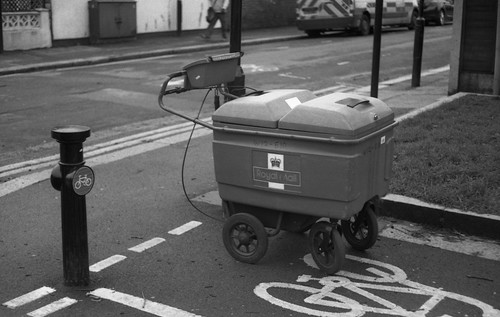
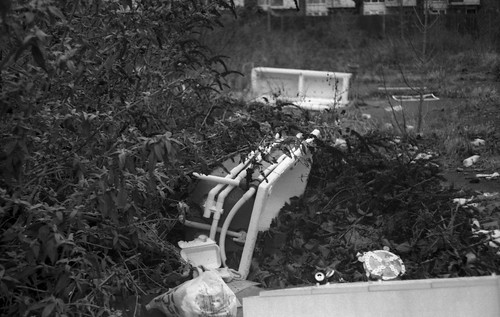












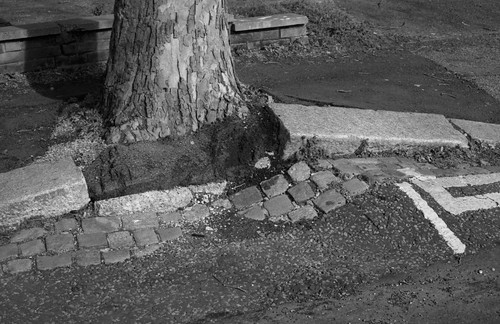


.jpg)










